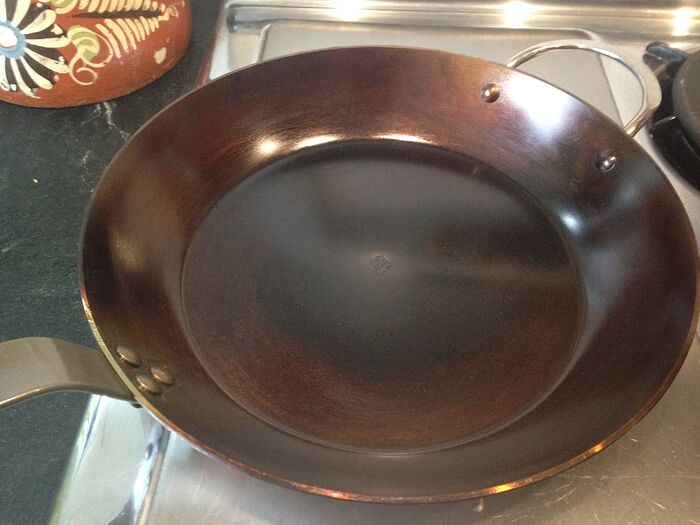Purchased a DeBuyer Mineral 12.5” carbon steel pan and followed manufacturer’s directions for seasoning: wash wax coating off with hot water, heat a thin layer of oil (I used Canola) to the smoking point, clean w/hot water and . . .start cooking. After a week the pan had a rim of gloppy, ridgey hardened oil along the sidewall. Yuck. Opinions vary on whether such stuff affects the pan’s performance, but every time I used the pan I felt irritated. YouTube research led me to Vollrath’s Instructional video: https://m.youtube.com/watch?v=xoIO8YOpyN4
Am posting this to provide a few observations and caveats not mentioned in the video.
- Initial cleaning: Tried Barkeeper’s Friend but it didn’t move the worst of the glop, so followed Vollrath’s recommendation and used oven cleaner to strip the pan. I sprayed it, sealed it in a plastic bag, and left it over night. Then used Barkeeper’s to scour last stubborn bits. Not factory clean, but good enough.
- Feel free to go down the rabbit hole of appropriate oils for seasoning! I decided to go with Vollrath’s recommendation and used flax oil.
- Started the long process described in the video: warmed the pan, applied a thin coat of oil, then heated the pan to the smoking point. Cooled to cold. Repeated eleven times.
Notes:
- Opinions vary (greatly!) but in my experience if I didn’t achieve smoking plus darkening, when the pan cooled there were tacky areas. Would these have “cross-linked” in the next heating? I don’t know. But I decided to be rigorous. If I had any tack, I re-heated until, when cooled, the pan felt dry, smooth and hard.
- The video demo is on a commercial range with a large diameter burner. My Chambers daisy burner puts out 9000 BTUs. This was not enough to heat the sidewalls. I had to hold the pan at angles to expose the sides to the flames — a pain! It took ten minutes to achieve a smooth, dark, hard coating on the sidewalls as well as the bottom. I decided this was worth it if I ever wanted to make tart tatin. Also I decided that after all this work I wanted to do a thorough job. One thing I learned : steel is not like copper (duh!): it does not conduct heat up the sidewalls efficiently.
- Beware: it stank. I have a large Vent-a-Hood & opened three windows and still after doing four layers in one go I felt a little light-headed. I can’t imagine doing this in an unvented room.
- By the end of eleven sessions the pan looks good. The area where the handle is attached never got hot enough to go as dark as the rest, but I didn’t have it in me to hold the handle over the flame like a blacksmith.
- When they say “thin layer” they mean thin. If I didn’t wipe and wipe with a paper towel, the layer stayed sticky. “Thin” in my experience meant a shine.
- Each layer doesn’t go dark evenly — there are dots and streaks, but they shouldn’t be dimensional. It feels smooth but didn’t look smooth until coat eleven. Hope that makes sense.
- Vollrath says this is a foundation seasoning & you still have to keep using oil or butter when cooking to achieve a non-stick surface. True! After all that work, I used a dab of butter & my eggs still stuck. But the pan looks awesome & I have faith that I’ll achieve non-stick Nirvana in time.
Disclaimers:
Was it worth it? I don’t know. I did it because I found conflicting reports about alternative (easier) methods everywhere, and I decided to trust Vollrath.
Did I do it right? I don’t know. There are so many conflicting opinions, and the video was frustratingly vague. YMMV.




